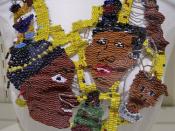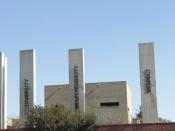The political content and the unique techniques of William Kentridge's work have propelled him into being one of South Africa's top artists. Working with what is in essence a very restrictive media, using only charcoal and a touch of blue or red pastel, he has created animations of astounding depth. A theme running through all of his work is his peculiar way of representing South Africa. He does not portray it as the very militant or oppressive place that it was for black people but he doesn't emphasize the picturesque state of living that white people enjoyed during Apartheid either. Instead he presents a city in which the duality of man is exposed. In his series of nine short films he introduces two characters, namely Soho Eckstein and Felix Teitlebaum. These characters depict an emotional and political struggle that ultimately reflects the life of many South Africans of the time.
In the introductory note to Felix In Exile Kentridge writes: "In the same way that there is a human act of dismembering the past there is a natural process in the terrain through erosion, growth, dilapidation that also seeks to blot out events. In South Africa this process has other dimensions. The very term 'new South Africa' has within it the idea of a painting over the old, the natural process of dismembering, the naturalization of things new."
Not only in Felix In Exile but in all his animated works the concept of time and change is a major theme that. The way he does this is through his erasure technique which contrasts with conventional cell animation whose seamlessness de-emphasizes the fact that it is actually a succession of hand-drawn images, This is implemented by drawing a key frame, erasing certain areas of it, then re-drawing them and thus...


